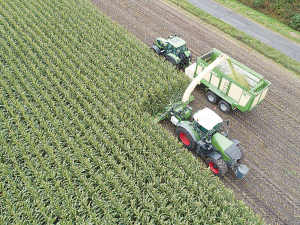Krone unveils new CombiPack HDP baler and halts US exports
Well-known for an extensive range of round balers, Krone’s new CombiPack HDP looks to have several features that sets it apart from its competitors.
 Krone has developed a prototype reverse-drive forage harvester that has been undergoing testing in maize.
Krone has developed a prototype reverse-drive forage harvester that has been undergoing testing in maize.
Anyone familiar with precision grass harvesting will remember the domination of the drum-type trailed harvesters of the 1980s and ‘90s.
This was overtaken by the popularity of flywheel type machines, which delivered more output, less fuel consumption and a better chance of surviving foreign object ingestion.
Those flywheel-based machines evolved from rear-linkage mounted, reverse drive machines that were the norm when forage maize became popular in northern Europe. This was at a time when self-propelled units were only just starting to appear.
German harvesting specialist Krone is now looking to turn the clock back and creating a sense of déjà vu with its latest development project – a prototype reverse-drive forage harvester that has been undergoing testing in maize.
Designed to be mounted on prime mowers like the Claas Xerion 5000 or the Fendt 1050, the prototype weighs over six tonnes and can be equipped with Krone’s six to 10 row maize, conventional grass pick-up or direct-cut, whole-crop headers.
It features a chopping cylinder from the Big-X harvester range, and hydraulically-driven header and feed rollers.
The prototype is said to be a match for Krone’s Big-X 480 cousin in terms of output and chop quality, with reduced fuel consumption and a significantly lower capital cost.
The Coalition Government will need the support of at least one opposition party to ratify the free trade deal with India.
Primary sector leaders have welcomed the announcement of a Free Trade Agreement between India and New Zealand.
At Pāmu’s Kepler Farm in Manapouri, mating has wrapped up at the across-breed Beef Progeny Test.
More than 150 people turned up at Parliament recently to celebrate the 20th anniversary of Horticulture New Zealand (HortNZ).
Biosecurity New Zealand says Kiwis should continue to keep an eye out for yellow-legged hornets (Vespa velutina) over the holiday season.
Fonterra has slashed another 50c off its milk price forecast as global milk flows shows no sign of easing.

OPINION: The release of the Natural Environment Bill and Planning Bill to replace the Resource Management Act is a red-letter day…
OPINION: Federated Farmers has launched a new campaign, swapping ‘The Twelve Days of Christmas’ for ‘The Twelve Pests of Christmas’ to…